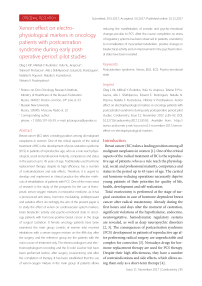Xenon effect on electrophysiological markers in oncology patients with postcastration syndrome during early postoperative period: pilot studies
Автор: Kit Oleg I., Rudenko Mikhail Y., Arapova Yulia Yu., Protasova Tatiana P., Shikhlyarova Alla I., Rostorguev Eduard E., Popova Natalia N., Kuznetsova Natalia S., Pozdnyakova Viktoria V.
Журнал: Cardiometry @cardiometry
Рубрика: Original research
Статья в выпуске: 11, 2017 года.
Бесплатный доступ
Breast cancer (BC) takes a leading position among all malignant neoplasms in women. One of the critical aspects of the radical treatment of BC is the development of post-castration syndrome (PCS) in patients of reproductive age, who as a rule reach physiological, social and professional maturity, competence and status in the period up to 45 years of age. Traditionally used hormone replacement therapy, despite its high efficiency, has a number of contraindications and side effects. Therefore, it is urgent to develop and implement in clinical practice the effective methods of rehabilitation of patients with PCS. One of the main areas of research is the study of the prospects for the use of therapeutic xenon-oxygen mixtures in restorative medicine, as it has a pronounced anti-stress, hormone-modulating, antidepressant and sedative effect. Accordingly, the aim of the present paper is to study the effect of xenon on cardiovascular system markers, brain bioelectric activity and psycho-emotional state in oncology patients with hormone-positive breast cancer in the stage of surgical castration...
Postcastration syndrome, xenon, eeg, ecg, psycho-emotional state
Короткий адрес: https://sciup.org/148308837
IDR: 148308837 | DOI: 10.12710/cardiometry.2017.11.8592
Список литературы Xenon effect on electrophysiological markers in oncology patients with postcastration syndrome during early postoperative period: pilot studies
- Ul'rikh A, Urmancheeva AF. Oncological aspects of menopausal hormone replacement therapy. Prakticheskaya onkologiya. 2009(10):76-78.
- Moiseenko TI, Popova NN, Men'shenina AP, Shikhlyarova AI, Nazaralieva NA. The results of a well-founded approach to correcting postovariectomy syndrome in oncogynecologic patients of reproductive age. Злокачественные опухоли. 2015(S2):136.
- Ciaramella А, Poli P. Assessment of depression among cancer patients: the role of pain, cancer type and treatment.Psycho -Oncology. 2001(1):156-165.
- Smetnik VP. Climacteric disorders and principles of hormone replacement therapy. Terapevticheskiy arkhiv.1995(10):70-74.
- Kit OI, Frantsiyants EM, Popova NN, Moiseenko TI, Men'shenina AP, Shikhlyarova AI, Goroshinskaya IA. Method of Correction of the Hormonal Status in Postastratic Syndrome in Patients with Cervical Cancer of the Reproductive Age. Patent na izobretenie №2619341 at 29.08.2016.
- Burov NE, Potapov VN. Xenon in Anesthesiology. Position and Perspectives in Russia. Xenon and Xenon Save technology in Medicine -2005. 2006.
- Salmi E, Laitio RM., Aalto S, Maksimow AT, Langsjo JW, Kaisti KK. Xenon does not affect y-aminobutyric acid type A receptor binding in humans. Anesthesia & Analgesia. 2008(106): 129-34 DOI: 10.1213/01.ane.0000287658.14763.13
- Uchida T, Suzuki S, Hirano Y, Ito D, Nagayama M, Gohara K. Xenon-induced inhibition of synchronized bursts in a rat cortical neuronal network. Neuroscience. 2012(214): 149-58 DOI: 10.1016/j.neuroscience.2012.03.063
- Roehl AB, Goetzenich A, Rossaint R. A practical rule for optimal flows for xenon anaesthesia in a semi-closed anaesthesia circuit. Eur. J. Anaesthesiol. 2010(27): 660-5 DOI: 10.1097/EJA.0b013e328336ec3b
- Timofeeva I, Philimonenko YuI Colored Test by M. Luscher (Standardized Version): a Methodical Guide. St. Petersburg: Imaton; 2000.
- Rudenko MYu, Zernov VA, Voronova OK, Mamberger КК, Makedonskii DF, Rudenko SM. Guide for «Cardiocode» Using the Method of the Analysis of the Phase of the Heart Cycle. Taganrog: IKM; 2015.
- Vermeulen RFM, Beurden MV, Korse CM, Kenter GG Impact of risk-reducing salpingo-oophorectomy in premenopausal women. Climacteric. 2017(20):212-221 DOI: 10.1080/13697137.2017.1285879
- Crouch A, Von AhD, Storey S. Addressing cognitive impairment after breast cancer: What do women want? Clin Nurse Spec. 2017(31):82-88 DOI: 10.1097/NUR.0000000000000279
- Zhirumskaya ЕА, Losevs VS. System of the Descriptions and Classification of Human Electroencephalograms. М.: Nauka; 1984.
- Schroth SC, Schotten U, Alkanoglu O, Reyle-Hahn MS, Hanrath P, Rossaint R. Xenon does not impair the responsiveness of cardiac muscle bundles to positive inotropic and chronotropic stimulation. Anest. 2002(96):422-7.
- Hanss R, Bein B, Turowski P, Cavus E, Bauer M, Andretzke M. The influence of xenon on regulation of the autonomic nervous system in patients at high risk of perioperative cardiac complications. Br. J. Anaesth.2006(96):427-36 DOI: 10.1093/bja/ael028
- Sarasso S, Boly M, Napolitani M. Сonsciousness and complexity during unresponsiveness induced by propofol, xenon, and ketamine. Current Biology. 2015(25): 1-7 DOI: .10.1016/j.cub.2015.10.014
- Coburn M, Maze M, Franks NP. The neuroprotective effects of xenon and helium in an in vitro model of traumatic brain injury. Crit. Care Med. 2008(36):588-95 DOI: 10.1097/01.CCM.0B013E3181611F8A6
- Kit OI, Shikhlyarova AI, Maryanovskay GV, Barsukova LP, Kuzmenko TS, Zhukova GV, Korobeinikova EP Theory of health: successful translation into the real life. Cardiometry. 2015(7): 42-46.


